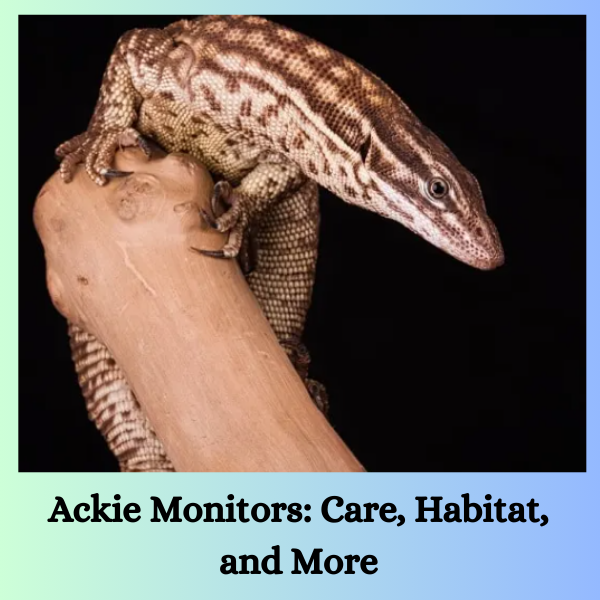Ackie Monitors: Care, Habitat, and More. In the vast realm of exotic pets, Ackie Monitors, scientifically known as Varanus acanthurus, have been steadily gaining popularity among reptile enthusiasts. With their unique appearance and fascinating behaviors, these captivating creatures have carved out a special place in the hearts of many.
Ackie Monitors: Care, Habitat, and More
If you’re considering bringing an Ackie Monitor into your life, or if you simply want to expand your knowledge about these incredible reptiles, you’ve come to the right place. In this comprehensive guide, we’ll delve deep into the world of Monitors, covering everything from their origins to their care requirements, habitat setup, and more.
1. The Fascinating World of Ackie Monitors
Ackie Monitors, also known as Spiny-tailed Monitors, hail from the arid regions of northern Australia. They belong to the Varanidae family, which includes some of the most intelligent and agile reptiles on the planet. These small to medium-sized lizards are renowned for their striking appearance, characterized by colorful scales, sharp spines, and a distinctive, inquisitive demeanor.
2. Varieties of Ackie Monitors
There are two prominent species of Monitors, namely the Yellow Ackie (Varanus acanthurus brachyurus) and the Red Ackie (Varanus acanthurus acanthurus). Both varieties are captivating in their own right, and each has unique characteristics that make them appealing to reptile enthusiasts.
2.1 Yellow Ackie (Varanus acanthurus brachyurus)
- Physical Features: Yellow Ackies are known for their vibrant yellow and orange coloration, which varies from individual to individual. They often display bold black markings on their tails and bodies.
- Size: On average, Yellow Ackies grow to be around 20-24 inches (50-60 cm) in length.
- Habitat: They primarily inhabit arid regions and are often found in rocky outcrops and burrows.
2.2 Red Ackie (Varanus acanthurus acanthurus)
- Physical Features: Red Ackies are recognized by their rich reddish-brown coloration with yellow patterns and spots. Their tails have a reddish hue, which distinguishes them from their yellow counterparts.
- Size: Red Ackies are slightly smaller, usually reaching lengths of 18-20 inches (45-50 cm).
- Habitat: They also prefer arid environments but may inhabit areas with more vegetation compared to Yellow Ackies.
3. The Ideal Ackie Monitor Enclosure
Creating the perfect habitat for your Ackie Monitor is crucial to their well-being. Here are some essential factors to consider when setting up their enclosure:
3.1 Enclosure Size
Monitors are active lizards that require ample space to explore and thrive. For a single adult Ackie, a minimum enclosure size of 4 feet long, 2 feet wide, and 3 feet tall is recommended. However, providing more space is always beneficial.
3.2 Temperature and Lighting
Maintaining the right temperature and lighting conditions is essential for Ackie Monitors. They need a basking area with a temperature range of 120-140°F (49-60°C) and a cooler zone around 80-90°F (27-32°C). UVB lighting is also crucial for their calcium metabolism.
3.3 Substrate
Choosing the right substrate is vital to mimic their natural environment. A mixture of organic topsoil, sand, and cypress mulch works well. This substrate aids in burrowing and maintaining humidity levels.
4. Ackie Monitor Diet and Feeding
Monitors are carnivorous and thrive on a diet of insects, small rodents, and occasionally, other small reptiles. It’s essential to provide a varied diet to ensure they receive all the necessary nutrients. Common food items include crickets, roaches, mealworms, and pinkie mice.
5. Ackie Monitor Behavior and Socialization
Ackie Monitors are known for their curious and intelligent nature. They can become accustomed to their owners’ presence with time and gentle handling. However, it’s essential to approach them with care and respect their space, especially during their adjustment period.
6. Ackie Monitor Health and Common Issues
Ensuring the well-being of your Ackie Monitor involves monitoring their health closely. Common health concerns include respiratory infections, metabolic bone disease, and parasites. Regular vet check-ups and proper husbandry practices are crucial in preventing these issues.
7. Breeding Ackie Monitors
Breeding Monitors can be a rewarding endeavor for experienced reptile keepers. Breeding requires meticulous planning, including providing a suitable nesting box and monitoring the female closely during the egg-laying process.
8. Conclusion
In conclusion, Ackie Monitors are captivating reptiles that can make excellent pets for dedicated enthusiasts. Understanding their unique needs, from enclosure setup to diet and socialization, is vital to their well-being and your enjoyment as a keeper. With the right knowledge and care, you can embark on a fulfilling journey of sharing your life with these remarkable creatures.
So, whether you’re a seasoned reptile enthusiast or someone new to the world of exotic pets, Ackie Monitors have a special place waiting for them in your heart and your home. Make sure to provide them with the love and care they deserve, and they will reward you with their fascinating presence.
FAQ
1. What size enclosure do Ackie Monitors need?
Ackie Monitors require an enclosure that is at least 4x2x2 feet in size for a pair.
2. How do I maintain the right humidity for my Ackie Monitors?
To maintain the proper humidity level, mist the enclosure daily and use a substrate that retains moisture.
3. What should I feed my Ackie Monitors?
Their diet should primarily consist of insects like crickets, roaches, and mealworms, supplemented with calcium and vitamins.
4. Can Ackie Monitors be kept in groups?
While they are generally solitary creatures, Ackie Monitors can be kept in pairs if the enclosure is large enough.
5. Do Ackie Monitors require UVB lighting?
Yes, they need UVB lighting to metabolize calcium and maintain their health.
6. Are Ackie Monitors good pets for beginners?
While they are manageable for beginners, they still require proper care and attention.



